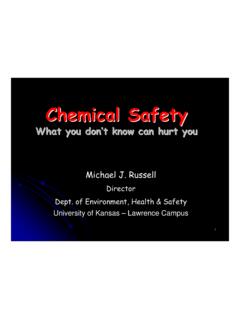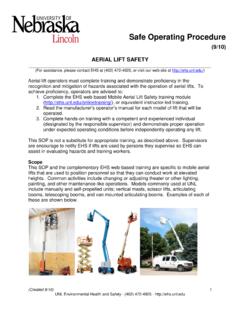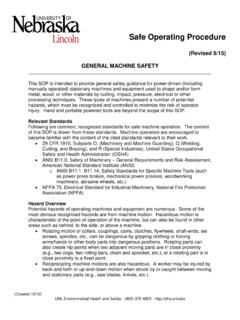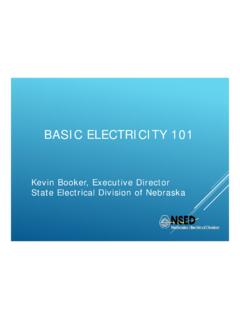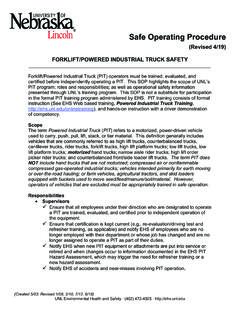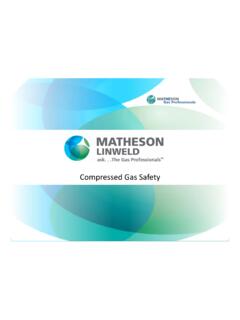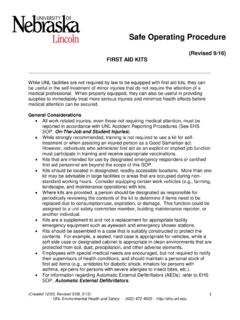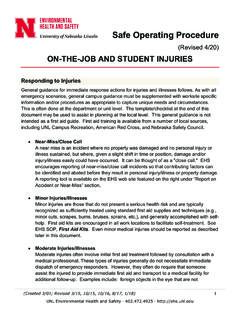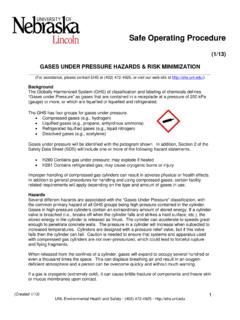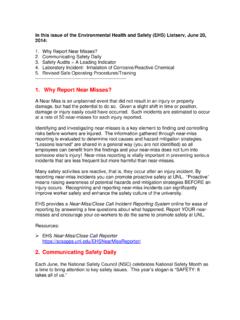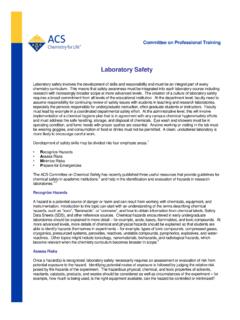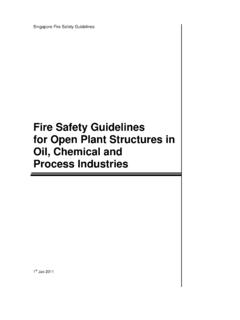Transcription of PERSONAL PROTECTIVE EQUIPMENT (PPE) – BODY …
1 (Created 7/12; Revised 11/15) UNL Environmental Health and Safety (402) 472-4925 Safe Operating Procedure (Revised 5/18) PERSONAL PROTECTIVE EQUIPMENT (PPE) BODY protection _____ This SOP provides information on the selection and use of outer garments, such as suits, chaps, vests, sleeves, coats, etc., to protect the body from injury. Specialized operations, such as PPE to protect against electrical shock/arc flash, are beyond the scope of this SOP. Body Hazards While there is no specific OSHA standard for body protection like there is for eye/face, head, foot, and hand protection , OSHA s general PPE requirements, 29 CFR , specifically state that PROTECTIVE clothing should be used when appropriate. Conditions that typically necessitate body protection include: Exposure to sharp knives or power cutting tools ( , chainsaw, etc.)
2 ; Exposure to temperature extremes ( , intense summer heat or winter cold, working in walk-in freezers/coolers, etc.); Contact with intense heat, including molten metals and other hot materials ( , steam, sparks, etc.); Contact with pesticides and other chemicals; Working with radioactive materials; Contact with infectious materials, including blood and body fluids; Contact with rough or abrasive surfaces; Working around motorized vehicles, operating bicycles, and other situations where there is a need to enhance a person s visibility. Materials of Construction Many different materials of construction are available for various PROTECTIVE body garments. Paper-like fiber used for disposable suits provide protection against dust and small splashes.
3 Treated wool and cotton adapts well to changing temperatures, is comfortable, fire-resistant and protects against dust, abrasions, and rough and irritating surfaces. Duck is a closely woven cotton fabric that protects against cuts and bruises when handling heavy, sharp, or rough materials. Leather is often used to protect against dry heat and flames. Rubber, rubberized fabrics, neoprene and plastics protect against certain chemical and physical hazards. When chemical or physical hazards are present, check with the clothing manufacturer to ensure that the material selected will provide protection against the specific hazard. (Created 7/12; Revised 11/15) UNL Environmental Health and Safety (402) 472-4925 Typical Laboratory Operations In a typical laboratory setting where small containers of biological agents, radioactive materials, or hazardous chemicals are handled, a lab coat is the minimum required body protection .
4 In this type of setting, potential for contact with significant quantities of hazardous materials/agents is relatively low. Lab coats protect the body against incidental exposure to hazardous agents and minimize potential for transferring hazardous agents to other areas through contaminated clothing. Lab coats come in a variety of materials of construction. Cotton and polyester/cotton blends will readily burn and are not appropriate when there is risk of clothing fire. Flame retardant lab coats should be selected when there is risk of clothing fire such as when working with flammable liquids and near open flames. Arc-rated lab coats (Nomex or equivalent) should be selected when working with pyrophorics or when there is risk of flash fire.
5 Cotton and cotton/polyester blends are generally suitable for work with radioactive materials or biological agents and provide a low- protection barrier for incidental contact and small splashes. When working with pathogenic organisms, a rear-closing gown may be more appropriate rather than a lab coat. Greater detail regarding PPE for biological agent protection is provided in the EHS Biosafety 201 and the Bloodborne Pathogens (including HIV/HBV/HCV) web-based training modules and associated Safe Operating Procedures, available through the EHS web site. When there is significant potential for chemical contact (such as large splashes), it may be necessary to layer chemical resistant sleeves or aprons over lab coats. protection from Chemicals In situations where the potential for chemical contact is greater than incidental, specialized chemical -resistant clothing is appropriate.
6 Selection of the proper chemical resistant clothing must consider: Body part(s) that could be exposed. This information will assist in the selection of the proper style. Full body coverage is necessary if there is potential for large splashes that could impact the legs, arms, and torso. If exposure potential is limited, then an apron, sleeves, or jacket may be sufficient. Physical state of the chemical contaminant. The highest level of skin protection is afforded with a fully-encapsulated suit. This type of suit is impermeable to gases and vapors and protects all parts of the body (hands, arms, head, face, torso, legs, etc.). A fully-encapsulated suit looks like a space suit. NOTE: No UNL employee is authorized to conduct tasks or enter atmospheres where a fully-encapsulated suit is necessary.
7 Non-encapsulating suits, jackets, aprons, and coveralls (depending on the body parts exposed) are appropriate to protect against liquid splashes and dusts/particulates. Non-encapsulating protection does not fully cover the wearer and has separate gloves and footwear even if a full body suit is used. Permeability and penetration with respect to the classes of chemicals of concern. The material of construction is an important consideration when selecting a non-encapsulating garment since different types of fabric/coatings have differing (Created 7/12; Revised 11/15) UNL Environmental Health and Safety (402) 472-4925 resistance to various chemicals (permeability). In addition, seams, openings, and fabric imperfections also influence the protectiveness of a garment (penetration data).
8 Similar to the approach taken with gloves, manufacturers will often test their products. Using the results of these tests, the manufacturer will provide recommendations for their products based on the types of chemical and physical state of the contaminants of concern. However, the data/recommendations are generally far less specific than that provided for gloves. Specialized Body protection High Visibility. Body protection garments are available to enhance a person s visibility ( , workers in construction zones, traffic controllers, etc.). There are two common ANSI standards associated with high visibility (HV) clothing, ANSI 107 and ANSI 207. When high visibility clothing is needed, choose clothing that meets the applicable ANSI standard or other national or international consensus standard.
9 Welding. Welding aprons, sleeves, bibs, and coats are available to protect against hot splashes from molten metals. The authority mandating welding PROTECTIVE clothing is ANSI , Safety in Welding, Cutting, and Allied Processes. However, this standard does not incorporate specific garment test protocols like it does for welding helmets and PROTECTIVE eyewear. Rather, it states: Clothing shall provide sufficient coverage, and be made of suitable materials, to minimize skin burns caused by sparks, spatter, or radiation. Heavier materials such as woolen clothing are preferable to lighter materials because they are more difficult to ignite. Cotton clothing, if used for protection , should be chemically treated to reduce its combustibility. Flame resistance should conform to the minimum specifications of ASTM D6413, NFPA 2112, or equivalent.
10 Chainsaws. In the United States, the primary performance standard for chainsaw PROTECTIVE clothing is ASTM F1897, Standard Specification for Leg protection for Chain Saw Users. When selecting leg protection for chainsaw use, select a manufacturer that adheres to this standard or an equivalent international consensus standard. Cut-resistance. Clothing to help protect against cuts can be made from a variety of materials. Most often, this type of clothing is not associated with any particular performance standard. Thus, selection is largely based on good judgment. In some cases, such as typical kitchen operations, sufficient protection may be afforded by a heavy apron. However, in a meat-packing-like operation kevlar or stainless steel mesh may be more appropriate.
